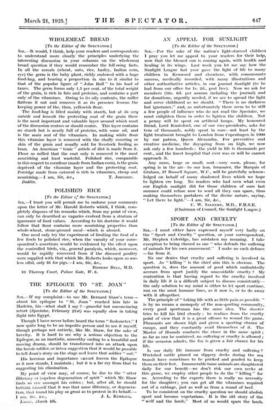WHOLEMEAL' - BREAD .[To the Editor of tuc " SPECTATOR.]
Sne,—It would, I think, help your readers and correspOndents to understand more clearly the principles underlying the interesting discussion in your columns on the wholemeal bread question if they would remember the foll hying facts. In all the cereals (wheat, oats, rice, barley, Indian corn, rye) the germ is the baby plant, richly endowed with a huge food-bag, and bearing a proportion in size to it similar to that of the popular figure of " John Bull " to his load of taxes. The germ forms only 1.5 per cent. of the total weight of the grain, is rich in fats and proteins, and contains a part only of the vitamines. Owing to its oily contents, the miller flattens it out and removes it as its presence lessens the keeping power of the, then, yellowish flour.
The food-bag is filled mainly with starch, but at its very outside and beneath the protecting coat of the grain there is the most important and valuable layer around which most of the discussion centres or should centre. This layer contains no starch but is nearly full of proteins, with some oil, and is the main seat of the vitamines. In making white flour this vitamine layer is removed with the chaffy covering or skin of the grain and usually sold for livestock feeding as bran. An American " tonic " article of diet is made from it. Flour so milled that the coat only is removed is the most nourishing and least wasteful. Polished rice, comparable in this respect to cornflour (made from Indian corn), is the grain deprived of the vitamine layer and the protecting coat. Porridge made from oatmeal is rich in vitamines, cheap and






















































 Previous page
Previous page